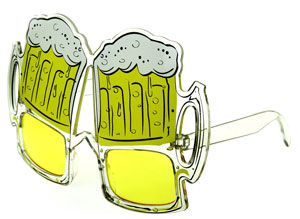“Beauty is in the eye of the beer-holder,” goes the old saying from college. Turns out, it’s true. Yes, there is such a thing as “beer goggles.”
The beer goggle effect is “an improvement in esthetic appearance of the opposite sex correlated with an increase in intoxication through ingestion of ethanol,” as defined by some guy sitting next to me on a barstool.
In simpler terms, he continued, “the more you drink, the better she looks.” And it doesn’t work just for men. The same effect goes for women.
Sure, we already know that drinking alcohol can affect your eyes. Police officers use the horizontal or vertical gaze nystagmus test on suspected drunk drivers.
|
|

|
But do “beer goggles” actually affect your vision—or just your perception? It seems it may be both. Here’s some of the evidence.
- Visual discrimination decreases when drunk. People with symmetrical facial features are, in general, perceived as more attractive. “Alcohol intoxication can be attributed at least in part to a reduced ability to discern facial asymmetry due to reductions in levels of visual perception,” according to researchers in Brazil, who published their findings in the journal Perception. “Intoxicated subjects were significantly less able to detect asymmetry than were sober subjects, providing support for the hypothesis.” In simplest terms, when you drink, your brain gets lazy, and people start to look better.
A more recent study found that, when viewed through “beer goggles,” good-looking people become no more attractive. However, ugly people (or, in scientific terms, faces with “low attractiveness”) do get better looking. (Interestingly, alcohol can make ugly landscapes look better, too.) Researchers in China concluded: “Attractiveness ratings for moderate- and low-attractiveness faces were significantly higher in the alcohol compared with placebo condition, while there was no significant difference for high-attractiveness stimuli between these two conditions. As for landscapes, only low-attractiveness stimuli were rated significantly higher in the alcohol condition.”
- Visual acuity decreases when drunk. Alcohol consumption decreases visual acuity and makes faces appear less clear—which makes people look more attractive, according to a team of researchers led by Cho Hyun-gug, a professor of visual optics at Kyungwon University. Their findings were published in the Journal of the Korean Ophthalmic Optics Society. (Good luck tracking down this journal. I couldn’t find it.) The researchers recruited 10 adults to drink one bottle 40-proof alcohol in 30 minutes. One hour after drinking, the subjects’ average blood-alcohol level was at its highest at 0.32% and their vision had fallen an average of 0.32 diopters from when they were sober. (A blood alcohol level of 0.32% is incredibly high—enough to render a person unconscious. This is probably a misprint from the secondary source, and should really be 0.032%. Again, I can’t locate the original source. Please pass it along if you can find it.)
- Judgment decreases and emotions increase when drunk . In the brain, alcohol sneaks into the neurons and affects both neurotransmitters and neuroreceptors. It slows down certain neuroprocesses while it speeds others up, and it does this in all areas of the brain. Specifically, in the limbic system, alcohol can inhibit memory loss and exaggerate emotions. Alcohol also raises dopamine levels, which leads to excitement and stimulation. In the hypothalamus, alcohol increases sexual arousal. Alcohol also enhances the function of certain neuroreceptors, which reduces anxiety. Alcohol also raises endorphin levels, which numbs pain and makes you feel good. So, “beer goggles” can make you less mindful, less inhibited, more emotional and more confident.
Speaking of alcohol and the brain, booze affects vision through an impaired neurosensory process in the occipital lobe (the brain’s visual processor). Specifically, alcohol seems to suppress the metabolism of glucose in the brain. Among all the noodles in your brain, the occipital lobe is the one that becomes especially impaired, consuming 29% less glucose than it should. With less glucose metabolism, the brain cells work less efficiently and can’t properly process what you see. Indeed, other researchers found that alcohol reduces visual cortical activation (to a light stimulus) by 33%.
Bear in mind that the effects of alcohol depend on a whole mess of factors: the amount ingested; how quickly it’s ingested; the size, the weight and, importantly, the gender of the drinker; how often the person drinks; as well as various genetic and environmental factors.
So, if you believe the research, beer goggles do work.
I’m a skeptic though, so I believe I’ll see for myself.
Another round, barkeep!
